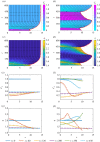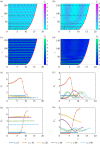A free boundary mechanobiological model of epithelial tissues
- PMID: 33362419
- PMCID: PMC7735320
- DOI: 10.1098/rspa.2020.0528
A free boundary mechanobiological model of epithelial tissues
Abstract
In this study, we couple intracellular signalling and cell-based mechanical properties to develop a novel free boundary mechanobiological model of epithelial tissue dynamics. Mechanobiological coupling is introduced at the cell level in a discrete modelling framework, and new reaction-diffusion equations are derived to describe tissue-level outcomes. The free boundary evolves as a result of the underlying biological mechanisms included in the discrete model. To demonstrate the accuracy of the continuum model, we compare numerical solutions of the discrete and continuum models for two different signalling pathways. First, we study the Rac-Rho pathway where cell- and tissue-level mechanics are directly related to intracellular signalling. Second, we study an activator-inhibitor system which gives rise to spatial and temporal patterning related to Turing patterns. In all cases, the continuum model and free boundary condition accurately reflect the cell-level processes included in the discrete model.
Keywords: cell-based model; continuum model; intracellular signalling; moving boundary problem; non-uniform growth; reaction–diffusion equations.
© 2020 The Author(s).
Conflict of interest statement
We declare we have no competing interests.
Figures







Similar articles
-
A hybrid discrete-continuum approach to model Turing pattern formation.Math Biosci Eng. 2020 Oct 29;17(6):7442-7479. doi: 10.3934/mbe.2020381. Math Biosci Eng. 2020. PMID: 33378905
-
A poroelastic mixture model of mechanobiological processes in biomass growth: theory and application to tissue engineering.Meccanica. 2017;52(14):3273-3297. doi: 10.1007/s11012-017-0638-9. Epub 2017 Feb 20. Meccanica. 2017. PMID: 32009677 Free PMC article.
-
A free boundary model of epithelial dynamics.J Theor Biol. 2019 Nov 21;481:61-74. doi: 10.1016/j.jtbi.2018.12.025. Epub 2018 Dec 19. J Theor Biol. 2019. PMID: 30576691 Free PMC article.
-
Continuum and Discrete Initial-Boundary Value Problems and Einstein's Field Equations.Living Rev Relativ. 2012;15(1):9. doi: 10.12942/lrr-2012-9. Epub 2012 Aug 27. Living Rev Relativ. 2012. PMID: 28179838 Free PMC article. Review.
-
Mechanobiological modelling of tendons: Review and future opportunities.Proc Inst Mech Eng H. 2017 May;231(5):369-377. doi: 10.1177/0954411917692010. Proc Inst Mech Eng H. 2017. PMID: 28427319 Review.
Cited by
-
Spatial Segregation Across Travelling Fronts in Individual-Based and Continuum Models for the Growth of Heterogeneous Cell Populations.Bull Math Biol. 2025 May 19;87(6):77. doi: 10.1007/s11538-025-01452-y. Bull Math Biol. 2025. PMID: 40388053 Free PMC article.
-
Multiscale Asymptotic Analysis Reveals How Cell Growth and Subcellular Compartments Affect Tissue-Scale Hormone Transport.Bull Math Biol. 2023 Sep 13;85(10):101. doi: 10.1007/s11538-023-01199-4. Bull Math Biol. 2023. PMID: 37702758 Free PMC article.
-
Mechanical Pressure Driving Proteoglycan Expression in Mammographic Density: a Self-perpetuating Cycle?J Mammary Gland Biol Neoplasia. 2021 Sep;26(3):277-296. doi: 10.1007/s10911-021-09494-3. Epub 2021 Aug 27. J Mammary Gland Biol Neoplasia. 2021. PMID: 34449016 Free PMC article. Review.
-
Mechanical Cell Interactions on Curved Interfaces.Bull Math Biol. 2025 Jan 7;87(2):29. doi: 10.1007/s11538-024-01406-w. Bull Math Biol. 2025. PMID: 39775998 Free PMC article.
References
Associated data
LinkOut - more resources
Full Text Sources
Miscellaneous

